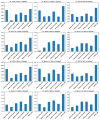MPHGCL-DDI: Meta-Path-Based Heterogeneous Graph Contrastive Learning for Drug-Drug Interaction Prediction
- PMID: 38893359
- PMCID: PMC11173658
- DOI: 10.3390/molecules29112483
MPHGCL-DDI: Meta-Path-Based Heterogeneous Graph Contrastive Learning for Drug-Drug Interaction Prediction
Abstract
The combinatorial therapy with multiple drugs may lead to unexpected drug-drug interactions (DDIs) and result in adverse reactions to patients. Predicting DDI events can mitigate the potential risks of combinatorial therapy and enhance drug safety. In recent years, deep models based on heterogeneous graph representation learning have attracted widespread interest in DDI event prediction and have yielded satisfactory results, but there is still room for improvement in prediction performance. In this study, we proposed a meta-path-based heterogeneous graph contrastive learning model, MPHGCL-DDI, for DDI event prediction. The model constructs two contrastive views based on meta-paths: an average graph view and an augmented graph view. The former represents that there are connections between drugs, while the latter reveals how the drugs connect with each other. We defined three levels of data augmentation schemes in the augmented graph view and adopted a combination of three losses in the model training phase: multi-relation prediction loss, unsupervised contrastive loss and supervised contrastive loss. Furthermore, the model incorporates indirect drug information, protein-protein interactions (PPIs), to reveal latent relations of drugs. We evaluated MPHGCL-DDI on three different tasks of two datasets. Experimental results demonstrate that MPHGCL-DDI surpasses several state-of-the-art methods in performance.
Keywords: data augmentation; drug-drug interaction; heterogeneous graph contrastive learning; meta-path; protein–protein interaction.
Conflict of interest statement
The authors declare no conflicts of interest.
Figures








Similar articles
-
HTCL-DDI: a hierarchical triple-view contrastive learning framework for drug-drug interaction prediction.Brief Bioinform. 2023 Sep 22;24(6):bbad324. doi: 10.1093/bib/bbad324. Brief Bioinform. 2023. PMID: 37742052
-
EDDINet: Enhancing drug-drug interaction prediction via information flow and consensus constrained multi-graph contrastive learning.Artif Intell Med. 2025 Jan;159:103029. doi: 10.1016/j.artmed.2024.103029. Epub 2024 Nov 20. Artif Intell Med. 2025. PMID: 39608043
-
Drug-drug interaction prediction based on graph contrastive learning and dual-view fusion.Comput Biol Chem. 2025 Aug;117:108426. doi: 10.1016/j.compbiolchem.2025.108426. Epub 2025 Mar 21. Comput Biol Chem. 2025. PMID: 40138848
-
Drug-drug interactions prediction based on deep learning and knowledge graph: A review.iScience. 2024 Feb 7;27(3):109148. doi: 10.1016/j.isci.2024.109148. eCollection 2024 Mar 15. iScience. 2024. PMID: 38405609 Free PMC article. Review.
-
A comprehensive review of deep learning-based approaches for drug-drug interaction prediction.Brief Funct Genomics. 2025 Jan 15;24:elae052. doi: 10.1093/bfgp/elae052. Brief Funct Genomics. 2025. PMID: 39987494 Free PMC article. Review.
Cited by
-
Machine learning-based drug-drug interaction prediction: a critical review of models, limitations, and data challenges.Front Pharmacol. 2025 Jul 30;16:1632775. doi: 10.3389/fphar.2025.1632775. eCollection 2025. Front Pharmacol. 2025. PMID: 40808680 Free PMC article. Review.
References
MeSH terms
Grants and funding
LinkOut - more resources
Full Text Sources
Medical

